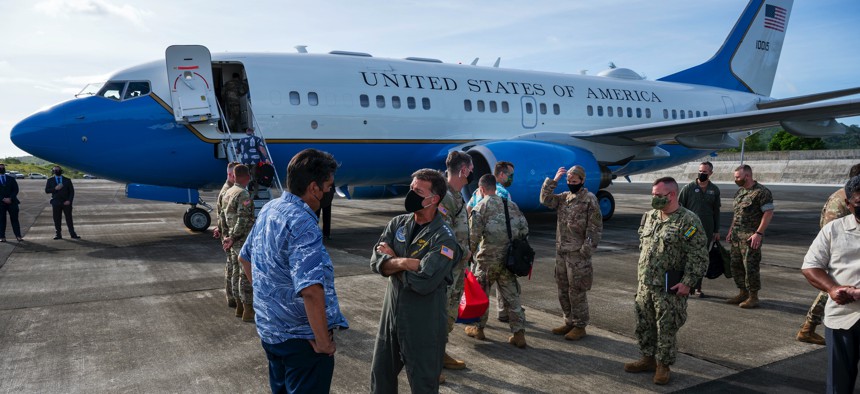
Adm. John Aquilino, commander of U.S. Indo-Pacific Command, says goodbye to Palau President Surangel Whipps Jr., left, during a February 2022 visit to the archipelagic country. U.S. Navy / Mass Communication Specialist 1st Class Anthony J. Rivera
Lawmakers Worry Pentagon Will ‘Shortchange’ INDOPACOM’s Budget Request
More than a dozen members of the House Armed Services Committee asked appropriators to bring the Pentagon’s 2023 spending proposal up to INDOPACOM’s request.
Some lawmakers are urging their colleagues not to lose sight of the threats posed by China, voicing concern that the Pentagon is trying to “shortchange” its mission in the Pacific.
Military leaders have named China the top threat facing the Defense Department, but the Pentagon’s 2023 budget request for the region appears lower than the amount Indo-Pacific Command officials said they need in a March 2022 report to Congress obtained by Defense One. More than a dozen lawmakers are asking leaders of the House Appropriations Committee to boost funding to suit.
“The crisis in Ukraine underscores the need to act with urgency when it comes to defending Taiwan,” said Rep. Michael Gallagher, R-Wisc., who led the letter, which was shared exclusively with Defense One. “Admiral [John] Aquilino clearly outlined to Congress what he needs to deter [Chinese Community Party] aggression in the Indo-Pacific, and any attempt to shortchange his request will not only undermine our ability to defend Taiwan, but will also be met with strong, bipartisan opposition in Congress.”
The letter was signed by 10 Republicans and five Democrats on the House Armed Services Committee, including Rep. Michael Turner, R-Ohio; Rep. Seth Moulton, D-Mass.; Rep. Liz Cheney, R-Wyo.; and Rep. Joe Courtney, D-Conn.
China is the Defense Department’s primary concern, according to an unclassified fact sheet about the Pentagon’s National Defense Strategy that was released in March. Though the fact sheet lists other threats of concern, including Russia, North Korea, Iran, and violent extremists, the report identifies Beijing as “our most consequential strategic competitor and the pacing challenge for the department.”
Last year, Congress directed Indo-Pacific Command to conduct an independent analysis of its funding requirements for 2023. In the “Seize the Initiative” report, officials said they need nearly $9.1 billion for 2023, and almost $67 billion between 2024 and 2027, according to an unclassified copy of the report shared with Defense One.
The Pentagon’s proposed Pacific Deterrence Initiative funding for 2023, however, is only $6.1 billion, according to an April 2022 comptroller document shared with Defense One.
“We’ve seen this for a couple years, where DOD seems to be adjusting what INDOPACOM has identified as its requirements and ultimately we defer to the commanders on the ground,” a congressional staffer said. “We have members who are saying, for appropriations this year, we need to give INDOPACOM everything it’s asking for.”
The Pentagon did not return a request for comment on the discrepancy.
It’s not clear whether there are priorities from Indo-Pacific Command’s report that were not included in the Pacific Deterrence Initiative, which is not a separate budget but rather collects in one place funding for various programs that are already in the overall budget request, or whether the two documents are categorizing spending differently. But the Pacific Deterrence Initiative and Indo-Pacific Command’s report include similar tables that break down funding priorities in the region but have drastically different numbers.
For example, Indo-Pacific Command asked for $7.1 billion in 2023 to “modernize and strengthen presence” in the region. That same line item for the Pacific Deterrence Initiative for a “modernized and strengthened presence” is just $1.8 billion. Under a budget line to “improve capabilities available to USINDOPACOM,” the combatant command asks for $110 million, while the Pacific Deterrence Initiative requests just $25 million.
In other areas, the Pentagon’s request surpasses Indo-Pacific Command’s. The combatant command asked for just $61 million for logistics and maintenance capabilities in fiscal 2023. But “improved logistics, maintenance capabilities, and prepositioning of equipment, munitions, fuel, and materiel” would get $302.8 million under the Pacific Deterrence Initiative. The Pacific Deterrence Initiative also asked for $2.3 billion for “exercises, training, experimentation, and innovation,” while Indo-Pacific Command’s evaluation asks for $540 million.





